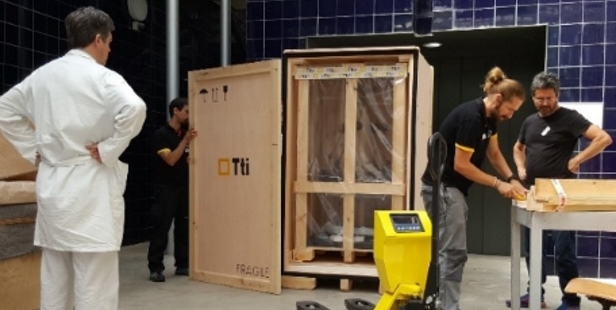Vicenç Martí & Carles Pongiluppi
In the exhibition Gaudí. Barcelona 1900, held in Florianópolis (Brazil) from 25th August until 30th October 2016, travelling afterwards to Sao Paolo, around fifty works were sent from the collection of the Museu Nacional d’Art de Catalunya, from paintings on canvas of different formats, to plaster and bronze sculptures, including ceiling lights, modernist furniture, models and ceramics.
Preparing the works for travel
When an exhibition is inaugurated, not only has time and effort been invested in the idea, the guide, the selection and the localisation of the works to be illustrated, in the design of the space and graphics, in the lighting, in the catalogue, and in the communication, etc., but work is also carried out on prior tasks which are rather unknown to the public in general: the arrangement of the works so that they can travel and be exhibited in the best possible conditions.
We as conservators-restorers try to provide all the means available to us so that the works leave the museum on the way to where they will be exhibited in the best state of conservation, well protected, that they suffer as little as possible during the move, that they are not subjected to tensions or climatic changes during the journey, that the inevitable vibrations of the transport are unable to cause damage, and that, once exhibited, they are in a stable climatic environment, and that they are suitably illuminated so that they don’t suffer damage.
That’s why we propose the packing requirements according to the weight, the morphology of the work, the fragility, and the type of materials and size. We also specify the position in which the work should travel and the materials it should be packed in. The majority of the works go inside wooden closed packing cases, covered inside with layers of isolating materials and protective foam, both to absorb the vibrations as well as for maintaining stable temperatures and humidity for the maximum period of time. The specialised companies aim to tailor-make each case and to handle with great care both the works as well as the filled boxes. Each piece needs its specific packing according to its characteristics and this we could say is the touchstone for the works to be able to arrive in perfect conditions and with the least stress possible.
Protection of the back of a painting on canvas that took part in the exhibition
As is usual, after exhaustively documenting the state of conservation of the works so as to provide written and graphic evidence before travelling, we accompanied the pieces throughout their journey, from the first packing until the final location in the exhibition room. In this case, given the number of works, the volume and the complexity of the setting up, two conservators-restorers of the museum assumed the functions of couriers.
In the first stage, it was necessary to load them on to lorries, which were adapted both in terms of the suspension, as well as the air conditioning and security measures. The stowage of the boxes within the lorry is very important so as to avoid them moving or tipping over inside the vehicle. For security issues, the works are accompanied by an escort: Mossos d’esquadra (the Catalan police force), police or private security.
Loading the lorry for the departure of the works from the museum
As it was a transatlantic journey, it was necessary to use the plane for transport and to supervise the palletisation until the final destination. In this case the cargo travelled by lorry to Luxembourg, where the planes leave for Brazil with a big enough capacity for the crates.
Where is Florianópolis, our destination?
It is a city in the south east of Brazil, almost completely surrounded by the water of the Atlantic Ocean and of beaches. It is the capital of the Brazilian state of Santa Catarina and named in this way in homage to the former president Floriano Peixoto. The city is well-known due to the high quality of life of its inhabitants, being the Brazilian capital with the highest rating in the Human Development Index (HDI). The economy is based on information technology, tourism and services.
Where was the exhibition held?
The final destination of this first Brazilian stage was the Cultural Centre of Santa Catarina. Florianópolis – FCC Fundaçao Catarinense de Cultura.
Once the works had been unloaded in their place of destination, they were left closed in the boxes for 24 hours so that they could adapt to the environmental conditions. Also in this case, and after going ahead with the unpacking, it is always an expectant and emotional moment for everyone. Then it is checked to see if the works have suffered any sort of alterations or imperfections, and the state of conservation is revised once again, together with the conservator-restorer of the museum which is organizing the exhibition. Both professionals, by common agreement, sign a document in which this examination and any other incidents are reflected. Then the setting up begins, from the anchorage of the works, the incorporation of the security systems, and the illumination, to the completion with the collocation of the explanatory posters.
Objects of decorative arts and sculptures shortly before finishing the setting up
The works of the museum have been on a long journey so that thousands of Brazilians can enjoy them in their own ‘home’. We accompany them and look after them as far as necessary to make them known. For the time being, from 30th October onwards, we will have to package them again and accompany them to Sao Paulo, where the public will once again be able to enjoy them as of 19th November.
Recommended links
Gaudí: Barcelona 1900. Dossier de prensa.PDF (Spanish)
The photographs used were carried out by Àlex Masalles, Carles Pongiluppi and Vicenç Martí
Carles Pongiluppi &
Conservador-restaurador de suports de fusta






















